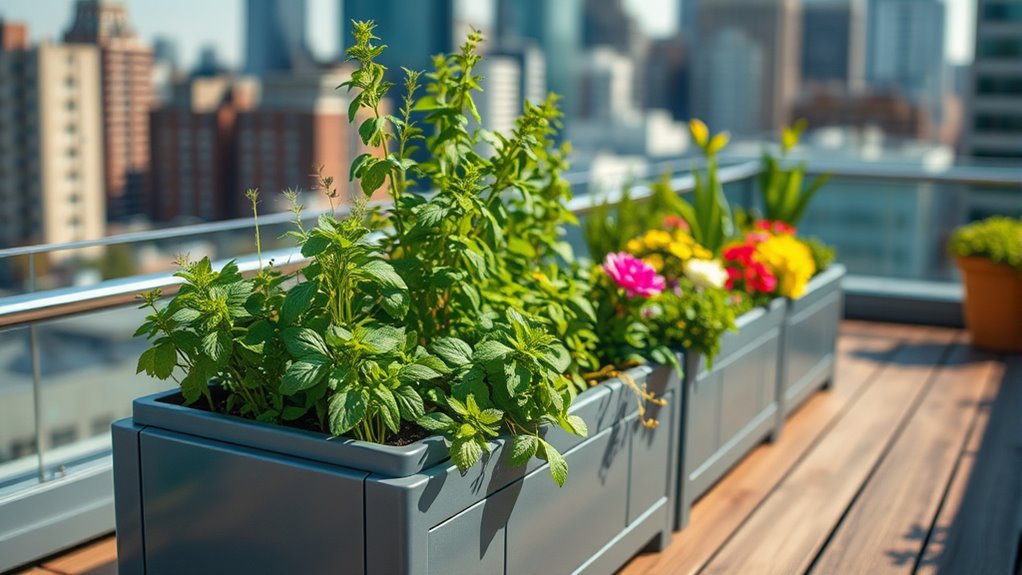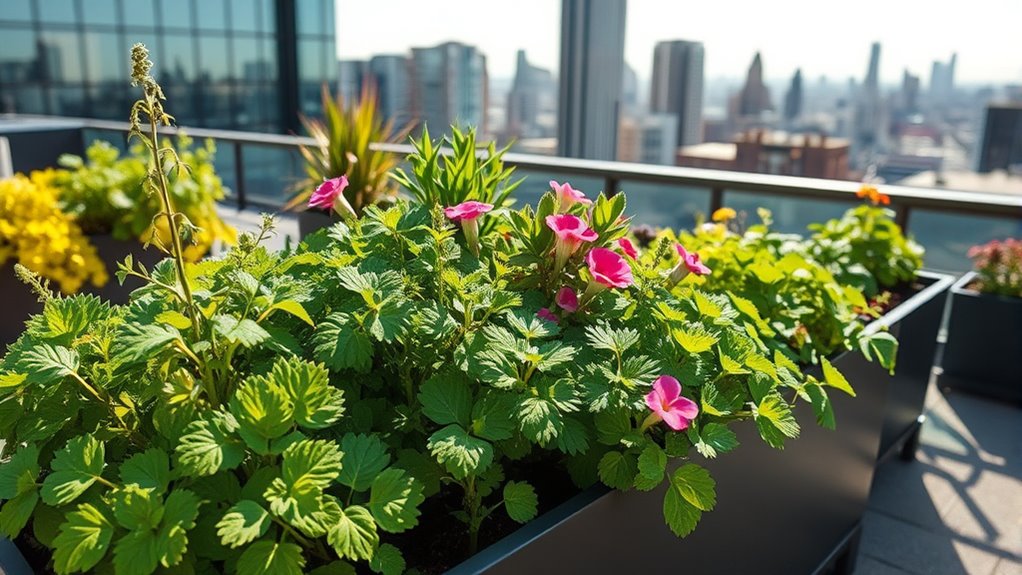If you’re an urban dweller looking to add greenery, portable gardens are a smart choice. They fit easily into small spaces like apartments or balconies and allow you to bring nature indoors. Choose plants that work well in containers, like herbs or small vegetables, and water them regularly—adjusting for container size and weather. With the right setup, you can enjoy fresh greens and vibrant plants. Keep exploring to learn how to make your portable garden thrive.
Key Takeaways
- Portable gardens maximize limited space, making them ideal for small apartments and city condos.
- Select plants suited for container growth, such as herbs, small vegetables, and shade-loving greenery.
- Regular watering with attention to container size and weather conditions ensures healthy plant growth.
- Use self-watering or drip irrigation systems to simplify maintenance in urban environments.
- Proper placement for sunlight and easy mobility enhances urban gardening success and enjoyment.

Portable gardens are an innovative solution for anyone looking to grow plants without the constraints of traditional landscaping. Whether you’re living in a small apartment or a compact city condo, these gardens let you bring greenery into your space with ease. The key to success starts with thoughtful plant selection. You want to choose plants that thrive in containers and suit your environment. Opt for herbs like basil, mint, and parsley—they grow quickly and are useful in the kitchen. Small vegetables such as cherry tomatoes or peppers can also flourish in portable setups if you provide enough sunlight. For low-light conditions, consider shade-loving plants like ferns or pothos. It’s essential to match your plant choices with your space’s light levels, temperature, and humidity to guarantee they flourish.
Once you’ve selected your plants, mastering watering techniques becomes essential. Portable gardens require different watering approaches compared to traditional gardens. Because containers drain faster and dry out quicker, you’ll need to stay attentive to your plants’ moisture needs. The best practice is to check the soil daily, especially during hot or dry weather, and water when the top inch feels dry. Using a watering can with a narrow spout allows you to target the base of each plant, minimizing water waste and reducing the risk of fungal diseases. For more efficient watering, consider setting up a drip irrigation system or self-watering containers. These systems help maintain consistent moisture levels, which is key for healthy plant growth and prevents overwatering or underwatering. Additionally, understanding the importance of mindfulness in your gardening routine can help you observe subtle plant cues and respond promptly to their needs.
Furthermore, it’s important to understand that watering techniques should be adjusted based on your specific plants and container sizes. For example, larger pots hold more soil and retain moisture longer, so they need less frequent watering. Conversely, smaller containers dry out quickly and may require daily attention. During hot summer months, you might need to water even twice a day. It’s also beneficial to water early in the morning or late in the afternoon to reduce evaporation and help plants absorb moisture effectively. Consistent watering not only supports healthy growth but also keeps pests and diseases at bay. Additionally, using room-temperature water helps prevent shock to your plants’ roots.
Frequently Asked Questions
What Are the Best Portable Garden Options for Small Balconies?
You should choose lightweight, durable containers like hanging baskets or stackable planters for your small balcony. Opt for container selection that’s suited for limited space, such as compact pots or vertical gardens. Focus on plant variety that thrives in containers—herbs, cherry tomatoes, or compact flowers. Regular watering and proper drainage keep your portable garden thriving, making your balcony vibrant and green without taking up too much space.
How Do I Prevent Pests in Portable Urban Gardens?
To prevent pests in your portable urban garden, start by choosing pest-resistant plants, which naturally ward off common pests. Keep your garden clean and remove dead leaves or debris that attract pests. Use natural pest control methods like introducing beneficial insects or spraying neem oil. Regularly inspect your plants for early signs of pests, and act quickly to prevent infestations from spreading. This proactive approach keeps your garden healthy and thriving.
Can Portable Gardens Sustain Edible Plants Year-Round?
Yes, you can sustain edible plants year-round in portable gardens by using season extension techniques like indoor planting or protective covers. Consistent container watering is essential to keep plants healthy through changing seasons. You should also consider moving containers indoors during harsh weather, ensuring proper light, and adjusting watering routines. With these practices, you can enjoy fresh produce regardless of the season, making your portable garden a sustainable year-round source.
What Is the Ideal Soil Type for Portable Garden Containers?
Back in the day, you’d choose a soil that’s a perfect blend of soil composition and water retention. For portable garden containers, opt for a light, well-draining mix like compost, peat moss, and perlite. This combination guarantees good aeration, prevents waterlogging, and keeps your plants healthy. Avoid heavy soils that retain too much water, as they can lead to root rot. A balanced, loamy soil is your best bet for thriving edible plants.
How Much Sunlight Do Portable Gardens Need Daily?
Your portable garden needs about 4 to 6 hours of direct sunlight daily. Make certain it gets adequate lighting requirements by placing it where it can receive consistent sunlight exposure, ideally morning or early afternoon sun. Adjust its position seasonally to maximize sunlight and prevent overexposure. Proper lighting is essential for healthy growth, so observe your plants and make changes to optimize sunlight exposure for the best results.
Conclusion
Imagine turning your tiny balcony into a lush oasis, much like a chef transforming a single ingredient into a delicious dish. Portable gardens give you that power, making urban living greener and more vibrant. Studies show city dwellers with small green spaces experience less stress and higher happiness. So, don’t wait—start small, move it around, and watch your city apartment bloom into a personal paradise, proving even the smallest space can grow big joys.









